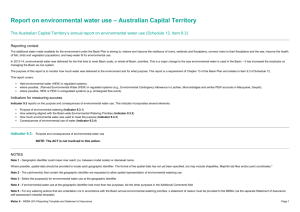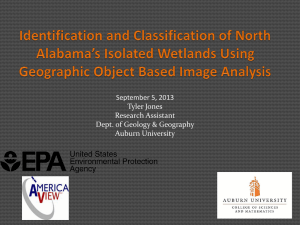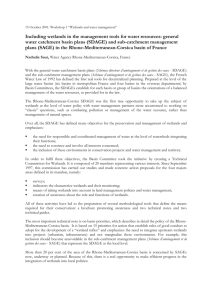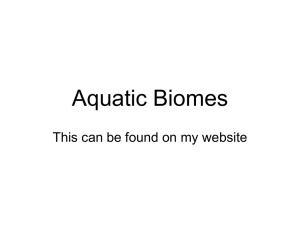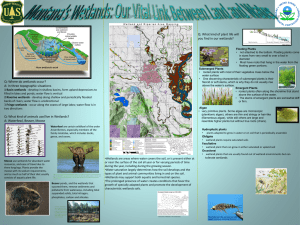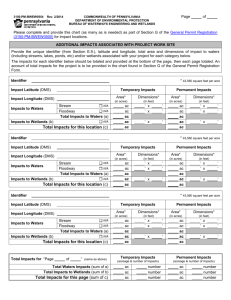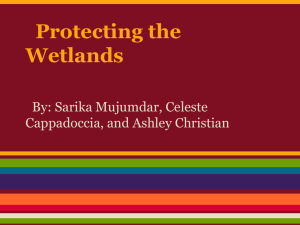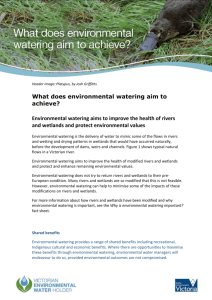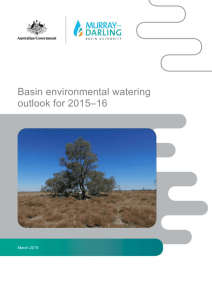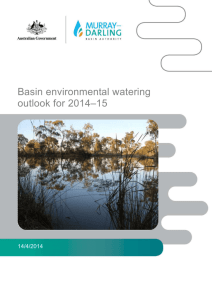DOCX - Murray-Darling Basin Authority
advertisement
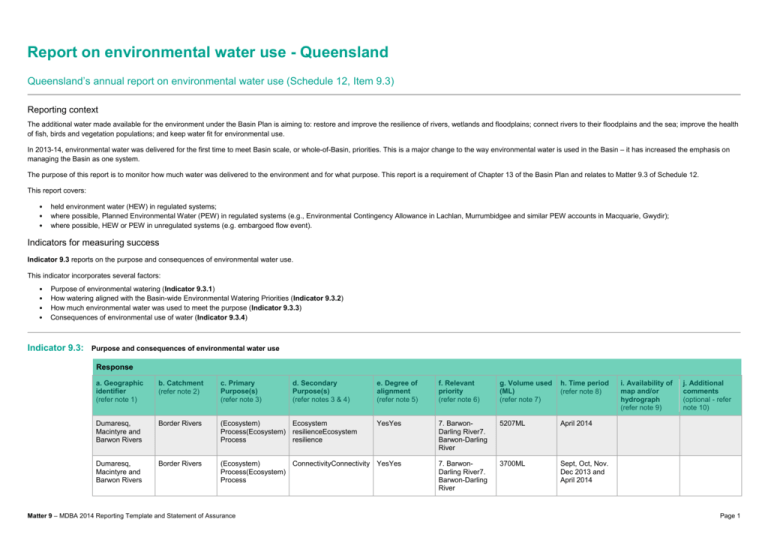
Report on environmental water use - Queensland Queensland’s annual report on environmental water use (Schedule 12, Item 9.3) Reporting context The additional water made available for the environment under the Basin Plan is aiming to: restore and improve the resilience of rivers, wetlands and floodplains; connect rivers to their floodplains and the sea; improve the health of fish, birds and vegetation populations; and keep water fit for environmental use. In 2013-14, environmental water was delivered for the first time to meet Basin scale, or whole-of-Basin, priorities. This is a major change to the way environmental water is used in the Basin – it has increased the emphasis on managing the Basin as one system. The purpose of this report is to monitor how much water was delivered to the environment and for what purpose. This report is a requirement of Chapter 13 of the Basin Plan and relates to Matter 9.3 of Schedule 12. This report covers: • • • held environment water (HEW) in regulated systems; where possible, Planned Environmental Water (PEW) in regulated systems (e.g., Environmental Contingency Allowance in Lachlan, Murrumbidgee and similar PEW accounts in Macquarie, Gwydir); where possible, HEW or PEW in unregulated systems (e.g. embargoed flow event). Indicators for measuring success Indicator 9.3 reports on the purpose and consequences of environmental water use. This indicator incorporates several factors: • • • • Purpose of environmental watering (Indicator 9.3.1) How watering aligned with the Basin-wide Environmental Watering Priorities (Indicator 9.3.2) How much environmental water was used to meet the purpose (Indicator 9.3.3) Consequences of environmental use of water (Indicator 9.3.4) Indicator 9.3: Purpose and consequences of environmental water use Response a. Geographic identifier (refer note 1) b. Catchment (refer note 2) c. Primary Purpose(s) (refer note 3) e. Degree of alignment (refer note 5) f. Relevant priority (refer note 6) g. Volume used (ML) (refer note 7) h. Time period (refer note 8) Dumaresq, Macintyre and Barwon Rivers Border Rivers (Ecosystem) Ecosystem Process(Ecosystem) resilienceEcosystem Process resilience YesYes 7. BarwonDarling River7. Barwon-Darling River 5207ML April 2014 Dumaresq, Macintyre and Barwon Rivers Border Rivers (Ecosystem) ConnectivityConnectivity YesYes Process(Ecosystem) Process 7. BarwonDarling River7. Barwon-Darling River 3700ML Sept, Oct, Nov. Dec 2013 and April 2014 Matter 9 ‒ MDBA 2014 Reporting Template and Statement of Assurance d. Secondary Purpose(s) (refer notes 3 & 4) i. Availability of map and/or hydrograph (refer note 9) j. Additional comments (optional - refer note 10) Page 1 a. Geographic identifier (refer note 1) b. Catchment (refer note 2) c. Primary Purpose(s) (refer note 3) Lower Balonne Lower Balonne Connectivity d. Secondary Purpose(s) (refer notes 3 & 4) e. Degree of alignment (refer note 5) f. Relevant priority (refer note 6) g. Volume used (ML) (refer note 7) h. Time period (refer note 8) Yes 1. Northern Basin Wetlands 6100ML April 2014 i. Availability of map and/or hydrograph (refer note 9) j. Additional comments (optional - refer note 10) NOTES Note 1 - Geographic identifier could mean river reach (i.e. between model nodes) or site/asset name. Where possible, spatial data should be provided to locate each geographic identifier. The format of the spatial data has not yet been specified, but may include shapefiles, MapInfo tab files and/or point coordinates." Note 2 - The catchment(s) that contain the geographic identifier are requested to allow spatial representation of environmental watering use Note 3 - Select the purpose(s) for environmental water use at the geographic identifier Note 4 - If environmental water use at the geographic identifier had more than two purposes, list the other purposes in the Additional Comments field Note 5 - For any watering actions that are undertaken not in accordance with the Basin annual environmental watering priorities, a statement of reason must be provided to the MDBA (via the separate Statement of Assurance self-assessment checklist template) Note 6 - Select the relevant priority corresponding to environmental water use. If environmental water use at the geographic identifier achieved more than one priority, list the other priorities in the Additional Comments field. 2013-14 Annual Watering Priorities 1. Northern Basin wetlands: Improve the resilience of colonial waterbird populations by supporting breeding events and improving breeding habitat in the Northern Basin wetlands. 2. Gwydir wetlands: Improve the condition and maintain the extent of wetland vegetation communities in the Gwydir wetlands (including Ramsar sites) by restoring hydrological connectivity and a flow regime that meets ecological requirements. 3. Macquarie Marshes: Improve ecosystem resilience amongst wetland vegetation communities in the Macquarie Marshes including Ramsar listed sites. 4. Lower Lachlan wetlands: Improve ecosystem resilience amongst wetland vegetation communities in the lower Lachlan wetlands 5. Mid-Murrumbidgee wetlands: Improve the condition of wetland vegetation communities in the mid-Murrumbidgee wetlands through a winter or spring fresh. 6. Lower Murray River system: Improve vegetation condition in wetlands and floodplains and provide cues for native fish recruitment and movement in the lower Murray River system by enhancing in-stream flow variability. 7. Barwon-Darling River: Improve habitat and provide opportunities for migration and reproduction of native fish in the Barwon-Darling River system by increasing flow variability and hydrological connectivity. 8. Lower Goulburn River: Improve habitat and provide opportunities for migration and reproduction of native fish in the lower Goulburn River through re-instating a variable flow regime which includes a large ‘in-channel’ spring/summer fresh. 9. Mid-Murray River: Improve habitat and provide opportunities for migration and reproduction of native fish in the mid-Murray River, including the Edward-Wakool and other smaller anabranches, distributary creeks and low-lying wetlands throughout the region. 10. Coorong, Lower Lakes and Murray Mouth: Facilitate Ruppia recovery by ensuring appropriate flows into the Coorong; and maintain the connection between the Lower Lakes to improve the water quality in Lake Albert. Note 7 - Total volume used to achieve the specified purpose(s) at the geographic identifier. May be reported per entitlement holder if desired. Note 8 - Time period during the year when environmental water use occurred. May be single date or period(s) Note 9 - This reportable property is designed to capture evidence of the consequences of the environmental water use (where possible). This evidence may come in the form of a map (i.e. of inundation extent) and/or hydrograph (observed or modelled) where relevant and able to be generated. This data will support case study narrative reporting on environmental water use. This field is intended to identify where inundation maps or hydrograph data can be generated and supplied." Note 10 - This simply provides a mechanism to capture any additional relevant information that may further explain or qualify other responses. Matter 9 ‒ MDBA 2014 Reporting Template and Statement of Assurance Page 2
